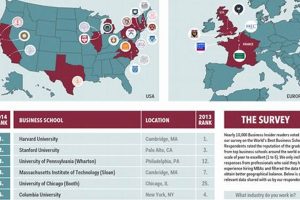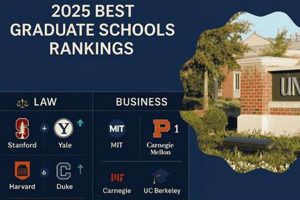Top-tier academic institutions offering exercise science programs typically provide rigorous curricula encompassing physiology, kinesiology, biomechanics, and nutrition. These programs often include hands-on learning experiences in laboratories and clinical settings, preparing graduates for careers in fields like athletic training, physical therapy, and cardiac rehabilitation. For example, students might engage in research projects analyzing human movement or developing exercise interventions for specific populations.
A quality education in this field is increasingly crucial due to growing societal emphasis on health, wellness, and physical activity. Graduates of highly-ranked programs are well-positioned to address the rising demand for professionals who can prevent and manage chronic diseases, enhance athletic performance, and promote overall well-being. Historically, the field has evolved from a primarily theoretical focus to a more applied, evidence-based approach, reflecting advances in scientific understanding and technological capabilities.
The following sections will delve deeper into the criteria for evaluating exercise science programs, explore career pathways available to graduates, and highlight some exemplary institutions leading the way in this dynamic field.
Tips for Selecting a Strong Exercise Science Program
Choosing the right academic program is a crucial step toward a successful career in exercise science. Careful consideration of several factors can significantly impact future opportunities.
Tip 1: Examine Faculty Expertise. Investigate the faculty’s research interests, publications, and professional experience. A program with faculty actively engaged in cutting-edge research offers valuable learning and networking opportunities.
Tip 2: Evaluate Laboratory Facilities. Modern, well-equipped laboratories are essential for practical training in areas like biomechanics, exercise physiology, and motor control. Access to advanced equipment allows students to develop hands-on skills crucial for professional practice.
Tip 3: Consider Internship Opportunities. Robust internship programs provide real-world experience and facilitate connections with potential employers. Look for programs with established partnerships with hospitals, clinics, and fitness centers.
Tip 4: Assess Curriculum Rigor. A comprehensive curriculum should cover foundational sciences like anatomy, physiology, and biochemistry, as well as specialized courses in areas like exercise prescription and rehabilitation.
Tip 5: Explore Career Services. Comprehensive career services, including resume workshops, mock interviews, and job fairs, can significantly enhance career prospects. Investigate the program’s placement rates and alumni network.
Tip 6: Research Accreditation. Ensure the program holds accreditation from reputable organizations, demonstrating adherence to high academic standards and professional best practices.
Tip 7: Consider Program Focus. Exercise science encompasses diverse specializations. Choosing a program aligned with specific career interests, such as clinical exercise physiology or strength and conditioning, is essential.
By carefully considering these factors, prospective students can identify programs that offer the best preparation for a rewarding career in exercise science. A well-chosen program provides a strong foundation for professional success and lifelong learning.
The concluding section will summarize key takeaways and offer final guidance for individuals pursuing a career in this exciting field.
1. Accreditation
Accreditation serves as a critical indicator of quality and rigor in exercise science education. For prospective students seeking the best programs, understanding the nuances of accreditation is essential. Accreditation signifies that a program meets established standards for curriculum, faculty qualifications, and facilities, assuring students of a comprehensive and high-quality educational experience.
- Regional Accreditation
Regional accreditation, granted by agencies recognized by the U.S. Department of Education, provides a broad assessment of institutional quality. For example, the Higher Learning Commission accredits institutions in the North Central region. Attending a regionally accredited institution ensures a baseline level of quality across all programs, including exercise science.
- Specialized Accreditation
Specialized accreditation focuses on specific disciplines or programs. The Commission on Accreditation of Allied Health Education Programs (CAAHEP) accredits programs in areas like exercise physiology. This type of accreditation signifies that a program meets rigorous standards specific to the profession, ensuring graduates are prepared for practice. Choosing a CAAHEP-accredited program can enhance a graduate’s employment prospects.
- Programmatic Accreditation
Some professional organizations, such as the National Strength and Conditioning Association (NSCA), offer programmatic accreditation for specific areas within exercise science, such as strength and conditioning. This designation demonstrates a program’s adherence to standards set by leading professionals in the field, indicating a commitment to best practices and career preparation. Graduates from NSCA-accredited programs may gain a competitive edge in the job market.
- International Accreditation
While less common in the U.S., international accreditation bodies, such as the British Association for Sport and Exercise Sciences (BASES), provide quality assurance for programs globally. Seeking internationally accredited programs can be beneficial for students interested in global career opportunities or for comparing program quality across different countries.
Accreditation status, whether regional, specialized, programmatic, or international, directly impacts the perceived value and reputation of exercise science programs. By prioritizing accredited institutions, prospective students invest in an education that meets recognized quality standards, enhancing their career prospects and professional development within the field.
2. Faculty Expertise
Distinguished faculty significantly contributes to the quality of exercise science programs. Expertise influences curriculum development, research opportunities, and student mentorship, shaping future professionals. Evaluating faculty credentials and accomplishments offers insight into a program’s academic rigor and commitment to excellence.
- Research Productivity
Faculty actively engaged in research contribute to the body of knowledge in exercise science. Publications in reputable journals, presentations at conferences, and grant awards demonstrate a faculty member’s commitment to advancing the field. Students benefit from exposure to current research methodologies and opportunities to participate in research projects, gaining valuable practical experience.
- Specialized Knowledge
Faculty with specialized expertise in sub-disciplines like biomechanics, exercise physiology, or nutrition enrich the curriculum and offer specialized mentorship. For example, a biomechanist specializing in gait analysis can provide unique insights into movement disorders and rehabilitation techniques. This specialized knowledge translates into more focused and in-depth learning experiences for students.
- Professional Experience
Faculty with practical experience in clinical settings, athletic training, or other related fields bring real-world perspectives to the classroom. This experience informs curriculum design, making it more relevant to professional practice. Students gain insights into the challenges and rewards of various career paths, facilitating informed career choices.
- Mentorship and Networking
Faculty serve as mentors, guiding students through academic challenges, career exploration, and professional development. Strong faculty mentorship fosters a supportive learning environment and provides students with valuable networking opportunities. Connections with established professionals can open doors to internships, research collaborations, and future employment.
The collective expertise of the faculty directly impacts the quality of education and training provided within an exercise science program. Institutions boasting accomplished faculty with diverse research interests, specialized knowledge, and practical experience offer students a richer learning environment and enhanced career prospects, solidifying their status as top-tier programs.
3. Curriculum Breadth
A comprehensive curriculum distinguishes top exercise science programs. Breadth of coursework ensures exposure to foundational knowledge and specialized areas, preparing graduates for diverse career paths. This exploration delves into essential curricular components contributing to a well-rounded education.
- Foundational Sciences
A strong foundation in biology, chemistry, and physics is crucial for understanding the physiological and biomechanical principles underlying human movement and exercise. For example, knowledge of anatomy is essential for analyzing movement patterns, while an understanding of chemistry is necessary for comprehending metabolic processes during exercise. Best exercise science schools ensure robust instruction in these foundational sciences.
- Exercise Physiology
In-depth study of exercise physiology examines the body’s acute and chronic responses to exercise. Coursework explores topics such as cardiorespiratory function, metabolic adaptations, and the effects of exercise on various physiological systems. This knowledge is fundamental for designing safe and effective exercise programs for diverse populations, a hallmark of top programs.
- Biomechanics
Biomechanics analyzes human movement using principles of physics and engineering. Coursework covers topics like kinematics, kinetics, and electromyography. Understanding biomechanics allows professionals to analyze movement efficiency, prevent injuries, and optimize athletic performance, crucial skills emphasized in leading exercise science programs.
- Nutrition and Exercise
The interplay between nutrition and exercise is crucial for health and performance. Coursework explores the role of macronutrients and micronutrients in exercise metabolism, recovery, and overall well-being. Understanding nutritional principles enables professionals to provide evidence-based dietary guidance to athletes and individuals seeking to improve their health, a key aspect of comprehensive exercise science education.
The breadth of curriculum directly influences career versatility and preparedness. Top exercise science schools offer comprehensive coursework encompassing foundational sciences, exercise physiology, biomechanics, and nutrition. This breadth equips graduates with the knowledge and skills to excel in diverse career settings, from clinical exercise physiology to strength and conditioning, marking a key characteristic of high-quality programs.
4. Research Opportunities
Robust research opportunities distinguish top exercise science programs from others. Engagement in research cultivates critical thinking, problem-solving skills, and a deeper understanding of scientific inquiry. This experience provides students with practical application of theoretical knowledge, preparing them for evidence-based practice and advanced studies. Institutions prioritizing research often attract highly qualified faculty engaged in cutting-edge studies, creating a stimulating academic environment. For example, students might contribute to faculty-led projects investigating the effects of exercise on cardiovascular health or the biomechanics of athletic performance. This direct involvement in research fosters a deeper understanding of scientific methodologies and contributes to the advancement of the field.
Access to advanced research facilities, including specialized laboratories and equipment, further enhances the research experience. Opportunities to present research findings at conferences and contribute to publications provide valuable professional development and networking opportunities. For instance, a student participating in a biomechanics lab might utilize motion capture technology to analyze movement patterns and present their findings at a national conference. Such experiences enhance a student’s resume and demonstrate a commitment to scholarly pursuits, making them more competitive candidates for graduate programs and employment.
In summary, the integration of research opportunities within exercise science curricula contributes significantly to the development of well-rounded graduates prepared to contribute meaningfully to the field. The availability of these opportunities, coupled with access to advanced resources and expert faculty mentorship, signifies a commitment to academic excellence and distinguishes best exercise science schools. This emphasis on research not only benefits individual students but also advances the field as a whole, fostering innovation and discovery.
5. Career Placement
Strong career placement rates directly correlate with the quality of exercise science programs. Top-tier institutions prioritize career services and cultivate relationships with potential employers, creating a pipeline for graduates into desirable positions. High placement rates signify a program’s effectiveness in preparing students for the demands of the professional world. For instance, graduates securing positions in prestigious hospitals, research institutions, or professional sports teams reflect positively on the program’s rigor and reputation. Conversely, low placement rates may indicate deficiencies in curriculum, faculty expertise, or career support services. The strength of a program’s alumni network also contributes significantly to career placement success. A robust network provides graduates with access to mentorship, job opportunities, and professional connections, facilitating career advancement and long-term success. For example, an alumnus working as a lead physical therapist in a renowned rehabilitation center could offer mentorship and potential employment opportunities to recent graduates. These connections, fostered by strong alumni networks, contribute significantly to the overall career success of graduates. This cause-and-effect relationship between career placement and program quality underscores the importance of considering placement data when evaluating exercise science programs.
Furthermore, career placement services provided by best exercise science schools often include career counseling, resume workshops, mock interviews, and networking events. These resources equip students with the professional skills and connections necessary to navigate the job market effectively. A well-structured internship program also plays a crucial role in career placement, providing students with practical experience and exposure to potential employers. For example, an internship at a sports performance center could lead to a full-time position upon graduation. The quality and availability of internship opportunities directly impact a graduate’s preparedness for the workforce and contribute significantly to their career prospects. Ultimately, consistent high placement rates demonstrate a program’s commitment to student success, marking a critical differentiator between top-tier programs and others.
In conclusion, career placement outcomes represent a significant factor in assessing the quality of exercise science programs. High placement rates, coupled with comprehensive career support services and robust alumni networks, indicate a program’s effectiveness in preparing graduates for successful careers. Prospective students should prioritize programs with demonstrably strong placement records and consider this a key metric in their decision-making process. This focus on career outcomes, coupled with rigorous academics and research opportunities, distinguishes best exercise science schools and ensures a return on investment in education, contributing significantly to the advancement of the field and the success of its graduates. Challenges remain in accurately tracking long-term career trajectories and ensuring equitable access to career resources for all students, but the emphasis on career placement remains a crucial aspect of evaluating program quality and ensuring student success.
Frequently Asked Questions
This section addresses common inquiries regarding the pursuit of academic excellence in exercise science. Clarity regarding these points facilitates informed decision-making for prospective students.
Question 1: What distinguishes top exercise science programs from others?
Distinguished programs offer rigorous curricula, renowned faculty, advanced research facilities, and strong career placement support. These factors contribute to comprehensive student preparation for diverse career paths.
Question 2: How does accreditation impact program quality?
Accreditation ensures adherence to established standards for curriculum, faculty qualifications, and facilities. It signifies a commitment to quality assurance and enhances the reputation of a program.
Question 3: What role does faculty expertise play in student success?
Experienced faculty contribute specialized knowledge, mentorship, and research opportunities. Their contributions enrich the learning environment and foster professional development.
Question 4: Why are research opportunities important in exercise science education?
Research experience cultivates critical thinking, problem-solving skills, and a deeper understanding of scientific inquiry. It prepares students for evidence-based practice and advanced studies.
Question 5: How does curriculum breadth influence career prospects?
A broad curriculum exposes students to diverse sub-disciplines within exercise science. This breadth enhances career versatility and prepares graduates for a wider range of professional opportunities.
Question 6: What significance does career placement hold in evaluating programs?
Strong career placement rates demonstrate a program’s effectiveness in preparing graduates for successful employment. High placement rates suggest alignment with industry demands and effective career support services.
Careful consideration of these frequently asked questions provides prospective students with valuable insights into the key characteristics of leading exercise science programs. This understanding empowers individuals to make informed decisions aligned with their career aspirations.
For further exploration, the subsequent section offers a detailed analysis of specific career paths available to graduates of exercise science programs.
Conclusion
Premier institutions offering exercise science education provide students with the foundational knowledge, practical skills, and professional connections necessary for success in this dynamic field. Rigorous curricula, combined with research opportunities and expert faculty, cultivate critical thinking and prepare graduates for evidence-based practice. Accreditation, faculty expertise, curriculum breadth, research opportunities, and career placement rates serve as key indicators of program quality and should be carefully considered by prospective students.
The demand for qualified exercise science professionals continues to grow in response to increasing societal emphasis on health, wellness, and physical activity. Individuals seeking a career in this rewarding field should diligently research and select programs that align with their career aspirations and provide the necessary tools for long-term professional success. The future of exercise science hinges on the continued development of highly skilled professionals dedicated to promoting health and well-being across diverse populations.







